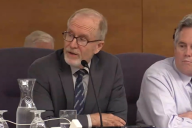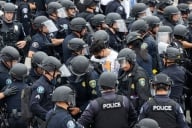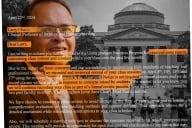You have /5 articles left.
Sign up for a free account or log in.
WASHINGTON – Some of the more than 300 college presidents who have signed a highly publicized open letter to politicians calling for stricter gun control measures and opposing concealed carry on campuses got a rude awakening from one of those legislators Tuesday.
A session about guns on campus at the annual American Council on Education meeting was sparsely attended, surprising given that the vast majority of college presidents oppose concealed carry at their institutions and yet are under siege by a growing number of state legislators seeking to legalize the practice. (Granted, the session did come at the very end of the conference.)
Then again, that might speak to the main point one politician in attendance sought to drive home. Alfonso H. Lopez, a Democratic member of the Virginia House of Delegates who helped address the aftermath of the 2007 Virginia Tech massacre, was recounting the legislation and activism that arose from that tragedy, crediting the many college presidents who spoke out to help make that happen.
Then, he fast-forwarded to December of last year, when Adam Lanza murdered 20 children and six adults at Sandy Hook Elementary School in Newtown, Conn.
“How many university presidents came forward?” Lopez demanded of the ACE crowd. “Zero.”
University of Saint Joseph President Pamela Trotman Reid wasted little time in pointing out that Lopez was way off; only a month ago, college presidents stood with U.S. Education Secretary Arne Duncan to publicize their December letter and its demands for reform.
But the message of College Presidents for Gun Safety, as the group calls itself, never reached Lopez, a strong supporter of gun control, despite widespread coverage in the news media and the recent backing of New York City Mayor Michael Bloomberg’s 900-member coalition Mayors Against Illegal Guns.
Lopez noted later on in the panel that Virginia’s assembly has a very short session -- just eight weeks -- in even years, which could have something to do with the letter, or any coverage of it, never reaching his desk. But he still insisted that the best thing presidents could do is to have a physical presence -- not just a paper one.
Ideally, this would involve presidents showing up in legislators’ offices, Lopez said. But universities also have state lobbyists who could be recruited to make their case -- a case best made when it invokes economic impact. (For instance, President X might say, “If you allow guns on my campus, I won’t be able to recruit the best professors, and the state can say goodbye to all the research and economic initiatives my university contributes to this economy.”)
In an interview after the session, Trotman Reid said Lopez’s not having seen the letter was concerning, but noted that it was directed more at the federal level. But she does know of other presidents who have sent the letter to state politicians or deployed lobbyists to pitch it.
Still, Lopez would argue more can be done.
“It comes down to physical presence. The most effective lobbying is when you have a university president in your office,” he said. “A letter will got lost -- especially a letter from outside the Commonwealth.”
The panelists talked at length about the need to restrict firearms on campuses, but they also discussed best practices for colleges whose state legislators have already won the battle -- or whose judges have overturned laws -- in favor of concealed carry.
Raul Cardenas Jr., associate vice chancellor for student affairs at the University of Colorado at Denver, praised threat assessment teams (also referred to as behavioral intervention teams) -- a growing trend now employed by most if not all campuses, said Steven J. Healy, managing partner at the campus safety consulting firm Margolis Healy and Associates – as the most viable tool for identifying potentially dangerous students or situations before they get out of hand.
But, long before a University of Kentucky dean in attendance shared a story in which soon-to-be graduates wanted armed guards at commencement because they were afraid of a student veteran who had been expelled, panelists got in a word of caution. Healy acknowledged that in some places, as Cardenas said, “fear is driving our behaviors.” But he said people can’t let that cloud their judgment of the environmental realities of college campuses.
Despite occasional shootings, college campuses are actually statistically safer than most other settings. But they do feature a number of qualities that make permitting firearms “very challenging,” Healy said. Prevalence of alcohol, immaturity of some students, and logistical storage issues are all practical problems that must be considered, he said.
Noting that the Kentucky situation “is something college officials have to deal with all the time,” Terry W. Hartle, ACE’s senior vice president for government and public affairs, asked the panel members what questions college officials should be asking themselves as these sorts of scenarios arise with increasing frequency.
Liability and risk should be top of mind, said Jessie Brown, ACE associate general counsel.
“If students are really feeling unsafe, you need to think about, what is the lawsuit you’d like to defend?” Brown said. “There’s this cost-benefit analysis of keeping the students feeling safe, keeping the other students feeling safe, and not violating anybody’s civil rights.”








